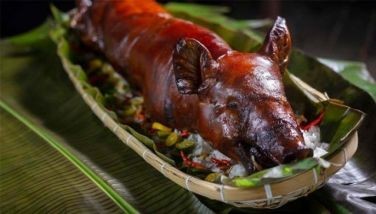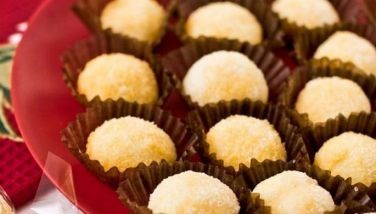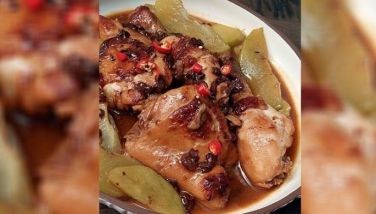The life & style of the Ilonggo
MANILA, Philippines - It used to be that the coffee table book was simply an ornament for the central table in the living room. Like a doorstop, it was used to weigh down the table and lend a certain vague intellectual note to it, hinting at the host’s cultural orientation and discreet good taste. New York, London and Paris were usually the source of these pricey coffee table books until Gilda Cordero-Fernando pioneered in creating the Philippine template for them.
Today, the coffee table book has evolved into something more substantial. Estilo Ilonggo, which had been envisioned to be the first in a series by the late Reynaldo Gamboa Alejandro in collaboration with Vicente Roman Santos, illustrates the new 21st century style of coffee table book. No longer simply ornamentation, it gives value for money since – in the more abstemious style after the economic crisis of 2009 – it is not only a pretty reflection of the Ilonggo lifestyle that it sets out to document and to project. It has also neatly divided its chapters into practical food-oriented segments and the reader can interactively try out the recipes thoughtfully laid out and beautifully illustrated. Hence, the words of the authors:
“Estilo Ilonggo picks up where (other) books and compilations leave off. It weaves together loose threads into a veritable hablon that leaves a palpable impression of the Ilonggo. Each chapter is a course in a meal. In turn, chapters are divided into sections, each beginning with a featured Ilonggo dish, because food is a universally delightful theme. From thence, it leads on fluidly to other related, loaded, bite-size morsels of Ilonggo history, arts, individuals, livelihood, customs and traditions, attractions and festivals. Thus, one gets to know the Ilonggo as one gets to know a new acquaintance over lunch, not as a specimen to analyze or worse, to dissect.”
This approach has a long literary tradition as one remembers that Marcel Proust’s “A la recherché du temps perdu” begins with the writer’s biting into a madeleine (our very own mamon), which brings back a whole slew of memories and associations of an extinct Parisian past.
21st century meets previous centuries as “bite size” morphs into “byte-size,” bearing in mind that today’s busily multi-tasking denizens have extremely limited concentration spans. Today’s couch potatoes can simply focus on a chapter of choice, possibly pick out a recipe or try to glimpse through history’s curtain for a bit of the Ilonggo’s golden past. However, the book does deserve more time and attention as it’s also an important tome on an ethno-linguistic group and a culture that have still not gotten their due in terms of Philippine social history.
After all, the region has produced more than its share of patriots, political leaders, scientists, thinkers, artists, musicians, innovators, beauty queens and rebels, etc. – proportionately gigantic compared to its relatively small area. The Hiligaynon culture encompasses Western Visayas, with its two distinguished provinces of Iloilo and Negros Occidental, but also covering the important sub-cultures of Capiz and Guimaras island. Ilonggo culture is a strong counterpoint to the central, dominant Visayan culture of the Cebuanos or even of the quaint strain of Leyte and Samar.
Fortunately for the Philippines, and as the late National Artist Nick Joaquin pointed out, the Philippine South was never ravaged or devastated (except for the Second World War) in the same way as the American South. It managed to preserve its culture and lifestyle, as may be glimpsed in Peque Gallaga’s film “Oro Plata Mata.” For better or for worse, the sugar baron estilo de vida persisted, way into the 20th century, when it finally collapsed under the twin blows of agrarian reform and the Marcos era. Miraculously, and possibly because of the Ilonggo’s justified pride in their heritage, their churches, baronial mansions, public buildings, social and cultural institutions, and – as the book points out – its spectacular cuisine have survived, to the delight of new generations of Filipinos bent on rediscovering their past.
Pride of place is what we have the Ilonggos to thank for and, indeed, its authors for artfully docume nting and recording the origins of specific Visayan dishes or specialties. Who would have guessed that the plethora of Ilonggo sweets came from the survival need of mahjongeras not to rise from the table while on a winning streak and simply have dainties like panara, baye-baye, butong-butong, tortitas and dulce gatas delivered from the kitchen? It is extremely instructive to learn that Japanese immigrants called imin were the source of the banana delicacy we now call the pinasugbo. Such gems and more can be harvested from this 252-page book, which, at the very least, should be a strong candidate for a National Book Award in its category.
nting and recording the origins of specific Visayan dishes or specialties. Who would have guessed that the plethora of Ilonggo sweets came from the survival need of mahjongeras not to rise from the table while on a winning streak and simply have dainties like panara, baye-baye, butong-butong, tortitas and dulce gatas delivered from the kitchen? It is extremely instructive to learn that Japanese immigrants called imin were the source of the banana delicacy we now call the pinasugbo. Such gems and more can be harvested from this 252-page book, which, at the very least, should be a strong candidate for a National Book Award in its category.
Just as the simple madeleine was able to evoke so much for Proust, so did this book result from a silver of an idea generated during a Valentine’s Day repast given by Patis Tesoro, who had suggested that a book be written with appropriate recipes on Ilonggo culture. Appropriately, the book has defined her as its muse. It has taken five long years and even the demise of one of the book’s authors (Ronnie Alejandro) and one of its proponents (Zafiro Ledesma II) to produce this important documentation of the vibrant and lively Philippine lifestyle and culture that we define as Ilonggo.
Contact Baby Buñag at 0917 8527564 to order copies of the book.
- Latest
- Trending



















